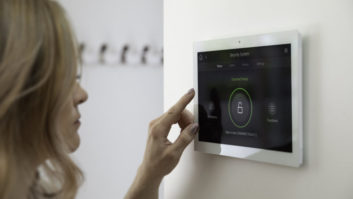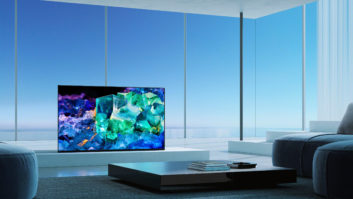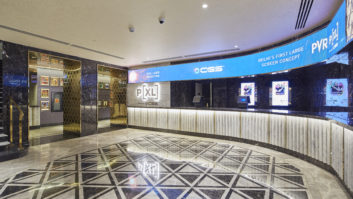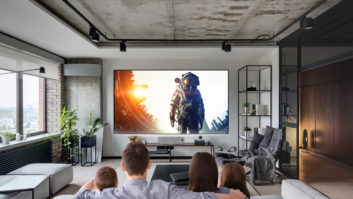Few years have been as challenging as 2020, with the pandemic wreaking chaos on both
the nation’s health and the wider economy.
But what has been the consequence for the residential custom install sector, and where is the market heading into 2021? We asked industry leaders how Covid has affected them, and the current state of consumer demand for installer staples like home cinema, Hi-Fi and smart home.
The good news is all our surveyed firms were upbeat about consumer demand, not least because consumers have a renewed appreciation of (stay at) home entertainment.
“This market is certainty looking promising for 2021 and beyond, as a lot of people will be spending more time at home, and more money on CI, AV and Hi-Fi,” confirmed Dan Raggett, general manager at music library specialist Melco Audio.
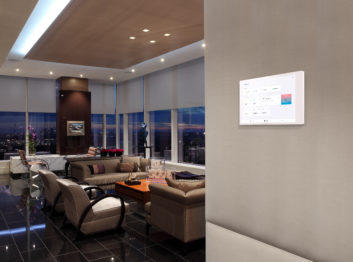 Control4 owner SnapAV is equally bullish. “As a result of the pandemic, SnapAV has actually witnessed the growth of smart living technology sales,” says G Paul Hess, chief product officer.
Control4 owner SnapAV is equally bullish. “As a result of the pandemic, SnapAV has actually witnessed the growth of smart living technology sales,” says G Paul Hess, chief product officer.
“This market was already expanding, even before
the pandemic struck.”
Hess cites ABI Research predicting that global revenues from smart home technologies were in line for a 21 per cent rise in 2020. After a brief slowdown, adjusting for the early economic impact of Covid-19, the market analyst expects demand to surge even more than originally projected. Its most recent study suggests the smart home market will be worth $317 billion by 2026, representing an additional 5 per cent of growth over pre-Covid-19 forecasts.
Stuart Tickle, managing director of CI distributor AWE, says that while nothing is certain, he’s “very” optimistic for 2021. “Entertainment and electronic systems may seem trivial compared to the pandemic itself, but never has it been more important for family members to enjoy spending time together at home and to keep in touch with loved ones. Working effectively from home has also become essential for many, which has resulted in the need for somewhere relaxing to ‘leave the workspace’ at the day’s end.”
Lockdown investment
There’s little doubt that largely locked down consumers are investing both more time and money in their home entertainment, says Andy Dowell, director of licensing for audio tech company MQA.
“During 2020, consumers have settled, and to some degree, invested, in their homes,” he told us. “Major industry players, as well as the companies feeding content to the resi install and AV market, have had to adapt to the COVID lockdowns. While a vaccine may see life slowly return to normal, some of the ‘Plan Bs’ devised to work during 2020, will continue in 2021, both as offerings to consumers who aren’t comfortable with the level of risk, and as ‘safeguards’ for similar situations in the future.”
Scott Campbell, director of sales for HARMAN Luxury Audio, whose brands include Arcam, JBL Synthesis, Lexicon and Mark Levinson, reports heightened interest in high-end AV solutions from residential integrators.
It was perhaps inevitable, he suggests “due to so many people being confined to their homes. We also see the demand for immersive home cinema AV products increasing with the emergence of streaming direct on launch of blockbuster movies.”
Campbell’s last point is a good one. The shuttering of the cinema industry has promoted studios to rethink how to distribute new films, with many selling titles to streaming services outright, or pursuing premium VOD options. The home theatre is no longer playing second fiddle to commercial cinemas.
Another ongoing trend is a rekindling of interest in home audio, from smart speakers to high-end audiophile solutions.
A number of factors continue to drive this rejuvenated audio market, says Harman’s Scott Campbell, “including the customer’s desire to increase not just the quality of their hi-fi system,
but also a wish to invest in timepiece-like beautiful designs, such as the recently launched Mark Levinson No.5105 turntable.”
Customers are also content to spend more on smart speakers, looking for both better performance and better design, which is where the Harman Kardon Citation line comes in, he notes.
“The continued increase in popularity of high-quality streamed recordings, including those from the likes of TIDAL and Qobuz, enables a pride of ownership and enjoyment in music, even though it is 100 per cent digital. Meanwhile, vinyl continues to impress old and newcomers alike, offering limited edition releases as well as high profile retail events.”
The market has definitely changed, but it’s become even more interesting, comments Melco Audio’s Dan Raggett. “There are so many people out there who love the sound of great music on a great system. Those people keep passing down their love of music and great sound quality onto younger generations, as well as family and friends…”
Streaming epidemic
One perhaps unexpected consequence of pandemic restrictions was a shift from live music in venues, to live music streaming over the internet.
MQA has been involved in a number of such projects, teaming with multiroom specialist Bluesound to deliver exclusive live concerts, in real-time MQA audio quality, direct to Bluesound owners’ homes. “This opened a new door for multiroom audio, your favourite artists and bands, live and exclusive throughout the home,” says MQA’s Andy Dowell.
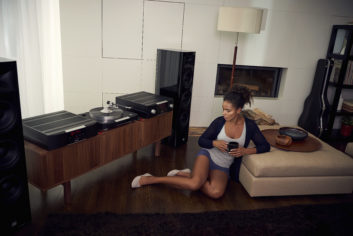 Simon Powell, operations director at Henley Audio, likes to put sustained interest in hi-fi down to the listening public’s continued love affair with vinyl. “Some really terrific pressings, and supreme mid-level decks, such as the £449 Pro-Ject Debut Carbon EVO, plus the increase in sales of top-tier music streaming services subscriptions, means an increased appetite for more capable hardware with which to showcase these quality music files,” he says.
Simon Powell, operations director at Henley Audio, likes to put sustained interest in hi-fi down to the listening public’s continued love affair with vinyl. “Some really terrific pressings, and supreme mid-level decks, such as the £449 Pro-Ject Debut Carbon EVO, plus the increase in sales of top-tier music streaming services subscriptions, means an increased appetite for more capable hardware with which to showcase these quality music files,” he says.
L-Acoustics Creations, a division of live audio specialist L-Acoustics, found symmetry in lockdown. As live streaming proliferated, it seemed ideally placed to ‘bring the concert home.’
“Our current products categorise end user needs in terms of sound systems or sound spaces,” explains Paul Keating, director of corporate & private relationships. “Our Archipel range of sound systems comprises a selection of our pro audio loudspeakers and amplifiers, specially selected and calibrated for home use. In addition to the 2.0 and 2.1 systems launched in 2020, the 2021 line-up will include surround and atmospheric configurations in 5.1 and 7.1.”
The company also offers Island Prestige, a personal auditorium system, and Ocean, a sound space solution based on its Syva loudspeaker technology – just the ticket if you need room filling audio in 9.1.8, 12.1.8 and 18.1.12 configurations.
“All our solutions integrate well within a conventional home streaming, home AV environment.”
L-Acoustics’ secret sauce is spatialized audio. “We call it Immersive Hyperreal Sound,” says Keating. “Our aim is to push sound into the sensorial and experiential realm, providing audio that is so realistic it confers the sensation of truly being there, at a concert, in nature, in an imaginary world of one’s choosing.”
As for what trends are driving the residential install market, Keating is clear: “It’s ubiquitous content, and we believe that the biggest opportunity for considerable qualitative gains in enjoying this content resides with audio. The technology is there to deliver extreme dynamics and fidelity at high SPL, including for exciting, spatialized formats such as Dolby Atmos.”
Getting smarter
Will 2021 also be the year of (even) smarter homes? Crestron’s John Clancy, residential VP, is optimistic.
“Every year I’d like to think our systems that go into customers’ homes get smarter and smarter and I do not see that stopping this coming year. People, having spent so much time at home in 2020, are willing to invest more in this area than ever before.”
Has Covid changed client expectations or impacted the kind of products they want? Who could have predicted home conferencing would become the next big thing at the start of 2020…
“100 per cent! How people expect to use their homes in the future has changed. For instance, we launched a product a few months ago called Crestron HomeTime,” says Clancy. “ It brings the concept of video conferencing via Zoom from the boardroom/conference room to the living room. It is ‘built into’ the space and controlled seamlessly with our handheld remote. That same device is used to control the TV and so much more (lighting, climate, blinds). No more trying to get the family around the laptop to video chat with grandma. Crestron HomeTime can obviously also be used to participate more comfortably in classes, where the living room becomes the virtual classroom and students’ laptops can be freed up and utilized as they would actually in class, for school work and/or note-taking. This type of solution, and so much more in this area, will certainly change expectations around smart home technology in the future.”
Green shoots
2020 may be notable for many things, but amid the chaos we also saw a new hi-fi distributor come to prominence. Fine Sounds UK, spun out of Denon and Marantz parent company Sound United, launched with an impressive array of clients, including McIntosh, Sonus faber and Basso Continuo.
The company rounded off 2020 by increasing its custom install dealer network with 12 new CI specialists. Andy Oattes, UK and Ireland sales director, is suitably enthusiastic about the market potential. “Residential install will continue to push forward and enjoy strong levels of business, with integrators ideally positioned to help consumers enjoy their time at home even more; ‘cocooning’ has been a trend that we’ve seen develop since the pandemic and this will continue.”
Oattes suggests we should anticipate a move towards higher-performance audio and video, driven by people reconnecting with music and movies and curious about quality. “Media rooms, home theatre, together with lighting and new control such as voice will also get strong growth,” he adds. “Large screens will start to see an uplift with new content via Hollywood, straight to streaming and 4k/8k.”
Oattes is such an unabashed advocate of high-end audio for CI, he’s created a new hashtag to support it!
Golden age of wireless
“I’ve been saying that we will see a new golden age for hi-fi for ages. If you follow the journey from when CD died and streaming happened, we have seen so many different and difficult experiences pushed onto the consumer. Now we have all the content and many, many easy ways to achieve mind-blowingly good performances without any compromise. Hi-Fi is genuinely disruptive. I call this #CI-FI or custom install fidelity!”
So moving forward, should pro AV installers and integrators rethink just how they specify and design for the residential space? Absolutely, says Oattes.
“Installers need to think more about the purpose of the system and design projects so that the client can achieve a better-sounding and visually exciting project. For too long a disproportionate amount of spend has been allocated to control. Now control is more commoditised/lower cost, the opportunity for integrators to thrill their customers with amazing performance is huge! Add to this a huge proliferation of music and video streamed content and amazing technologies, the future of performance is exciting.
“Object-based audio such as Auro-3D or DTS:X in home theatres, can be a very powerful experience with the right equipment. With headphone listening, it’s a fad, currently.”
Money spinners
So what are the big new money spinners for integrators? Home cinema, high-end hi-fi or smart home and security?
“It’s the integration of all of it,” says Clancy. “Which is why we have focused so heavily on Crestron Home. Like I said, people are using their homes more intensely and in and ways in which they have not previously. The opportunities for our dealers are huge. Our solutions for lighting, motorised shading, AV fully integrated with an awesome user experience all deliver tremendous value to end users and offer significant potential profitability to our dealers.”
And what of the integrator’s view? Mike Beatty, MD of leading custom install company Pulse Cinemas, says he didn’t see many integrators going out of business during the Covid outbreak.
“We’ve actually seen a reverse of that. We were hopeful that our industry would see an upturn in business and that’s precisely what’s occurred. As folk weren’t able to go out to enjoy the cinema, theatre, football matches, concerts. They seem to have been focused on updating their entertainment at home.”
And that’s good news for the residential install market, he says.
“I’ve always been an optimist; I guess that’s part of why we have been in business for almost 20 years. We at Pulse Cinemas have been investing heavily in processes, procedures and updating our headquarters in Stansted. We believe 2021 will see the industry succeeding like never before; with dealers working predominantly alongside brands and distributors who bring added value.”
Immersive spaces
David Fell, business development manager at Pulse Cinemas, concurs.
“There has been an increase in interest for the evolution of home entertainment systems during 2020, creating more immersive and dynamic spaces for the lockdown encouraging binge watching of favourite Netflix content. In addition, there has also been a marked interest in improving home IT systems to improve working from home, security systems for the home and an increase in enquiries for cyber security solutions.”
Beatty refutes any notion that interest in the traditional theatre, an AV staple of residential install, is waning: “Absolutely not, for those wanting a true cinematic experience, dedicated cinemas are still the preferred option for those dealers passionate about delivering their clients the ultimate experience!”
“I must confess that we have seen a huge upturn in cinema updates in living environments. It seems as though clients are asking for the best possible performance, but within their beautiful living spaces. They are requesting a space that has the ultimate comfort and design, but at a touch of a button evolves into a place to enjoy movies, sport, concerts, music… All of those experiences that have been temporarily lost to Covid.”
As with AV’s accelerated, homeworking-driven workplace revolution, it appears as if Covid may have a silver lining for residential AV too.
